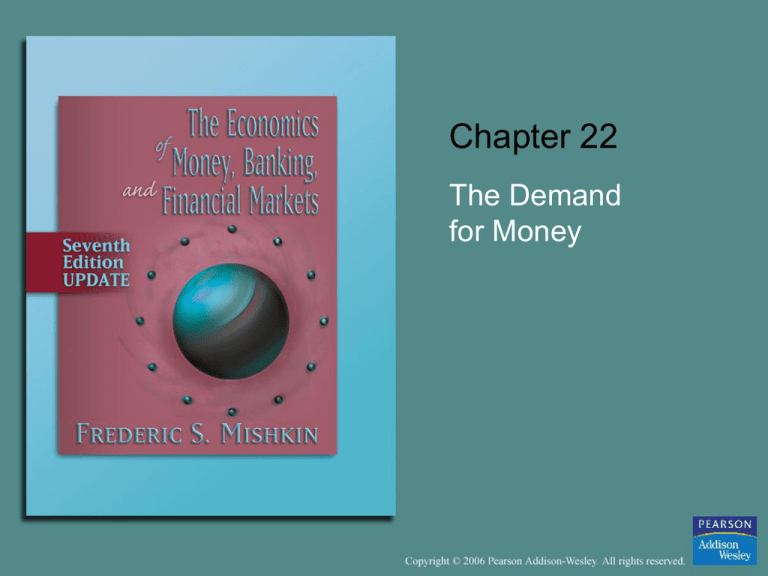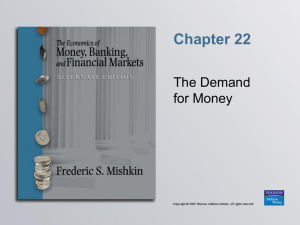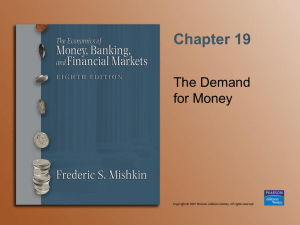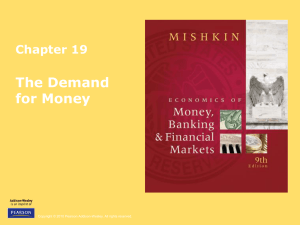
Chapter 22
The Demand
for Money
Quantity Theory of Money
Velocity of Money provides a link between the
quantity of money and nominal income:
V = (P Y)/M
Equation of Exchange: M V = P Y
Quantity Theory of Money
1. Irving Fisher: V is fairly constant
2. Equation of exchange is no longer an identity
3. Nominal income PY is determined by M
4. Classicals: Y is fairly constant in the short run
5. P is determined by M
Quantity Theory of Money Demand
M = (1/V) P Y
MD = k P Y
Implication: interest rates is not important to MD
22-2
Change in Velocity
from Year to Year: 1915–2002
© 2006 Pearson Addison-Wesley. All rights reserved
22-3
Is Velocity Constant?
1. Classicals thought velocity constant
because they didn’t have good data.
2. After the Great Depression, economists
realized that velocity is far from
constant.
© 2006 Pearson Addison-Wesley. All rights reserved
22-4
Keynes’s Liquidity Preference
Theory
3 Motives for Holding Money
1. Transactions motive - positively related to Y
2. Precautionary motive - positively related to Y
3. Speculative motive
A. Positively related to W and Y
B. Negatively related to i
Liquidity Preference: MD = P * L(Y, i)
+ -
© 2006 Pearson Addison-Wesley. All rights reserved
22-5
Keynes’s Liquidity Preference
Theory
Implication: Velocity is not constant
P/M = 1/L(Y, i)
Multiply both sides by Y and substitute in
MD = M → V = P Y/M = Y/L(Y, i)
1. i, → L(Y, i) → V
2. Change in expectations of future i, change
L(Y, i) and V changes
© 2006 Pearson Addison-Wesley. All rights reserved
22-6
Precautionary and Speculative MD
Precautionary Demand
1. Benefits of precautionary balances
2. Opportunity cost of interest foregone
Conclusion:
i, opportunity cost, hold less precautionary
D
balances, M
Speculative Demand
Problems with Keynes’s framework: Hold all
bonds or all money: no diversification
22-7
Friedman’s Modern Quantity Theory
D
Theory of asset demand: M function of wealth or permanent income (YP)
and relative return of other assets
MD/P = L(YP, rb – rm, re – rm, – rm)
e
+
–
–
–
Differences from Keynesian Theories
1. Other assets besides money and bonds: equities and real assets
2. Real assets as alternative asset to money implies M has direct effects
on spending.
D
3. rm not constant: rb, rm, (rb – rm) unchanged,
so
M
unchanged, i.e.,
d
interest
rates have little effect on M
D
4.M is a stable function
Implication of 3:
MD/P = L(YP) → V = Y/ L(YP)
Since relationship of Y and YP predictable, 4 implies V is predictable: Get
quantity theory result that change in M leads to predictable changes in nominal
income PY.
22-8
Empirical Evidence on Money Demand
Interest Sensitivity of Money Demand
Is sensitive, but no liquidity trap
Stability of Money Demand
1. M1 demand stable till 1973, unstable after
2. Most likely source of instability is financial
innovation
3. Cast doubts on monetary targets
© 2006 Pearson Addison-Wesley. All rights reserved
22-9







